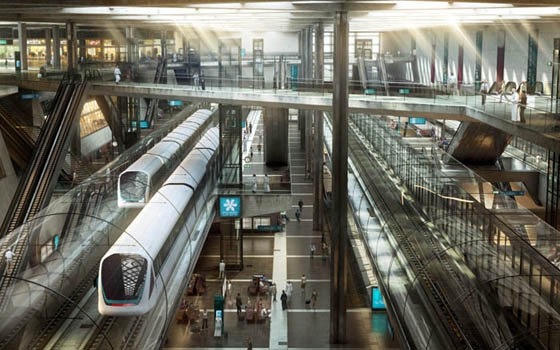The long-distance passenger and freight rail transportation system in Qatar, part of the wider GCC rail network currently under development, is moving closer to pulling out of the station.
In June, Qatar Rail – the state agency charged with developing the country’s railway network – announced it would be issuing tenders for the initial stage of construction on the long-distance rail before the end of this year, with construction set to begin in 2016.
Measuring progress
When fully completed in 2030, the planned four phases of the network will cover a distance of 400 km with links to Bahrain and Saudi Arabia, as well as freight and passenger lines to Qatar’s main population and economic centers, including Ras Laffan Industrial City, Dukhan and Al Shamal.
The initial phase of development will connect Doha to the industrial and logistics hub of Mesaieed and the new Hamad Port container terminal, before continuing on to the Saudi Arabian border, with 151 km of track and infrastructure to be built. Upon completion, the railway will be able to accommodate passenger train speeds of 200 km per hour (kph) and freight speeds of 120 kph.
LRT moving ahead
Other crucial transport projects in the country also remain on track. Work on the 38.5-km Lusail light rail transit system (LRT) is steadily progressing. The system is planning to link Doha with the new satellite city of Lusail, north of the capital, in addition to transporting passengers within Lusail.
The final award for the completion of the LRT was granted to a QDVC-Alstom joint venture in June 2014. “Phase 2C2 of the LRT, the southern portion, is expected to be completed and operational in February 2019, while Phase 2C, the northern portion, is set to be completed in February 2020,” Yanick Garillon, CEO of QDVC, the Qatar-based contracting and construction company leading the consortium for the Doha Metro Red Line-South, told OBG.
Metro on track
Meanwhile, plans for Qatar’s metro system are also moving ahead, with phase 1 of the Doha Metro project to include the three lines currently under construction, as well as 37 stations and supporting infrastructure.
Despite the project’s massive scale, it is running on schedule, Marc Krouse, financial managing director of PORR Bau (Doha Branch), told OBG. PORR Bau, a member of the consortium that also includes Saudi Binladin Group and HBK Contracting, is responsible for constructing Doha Metro’s 32-km Green Line Underground, starting in Msheireb in the east of the city, running through Education City and continuing west to Doha West International.
“This is the largest metro project of its kind ever undertaken in the world,” Krouse told OBG. “There are 21 tunnel-boring machines (TBMs) running at one time in the country, so the logistics of the entire operation are very complicated and require careful planning to ensure everything is completed on time.”
In June Qatar Rail officially announced that all TBMs were on track to complete the tunneling phase by 2017, and that 30 km or around 25% of the underground tunnels had been completed.
8.3 km of the 32 km of underground tunnels had been tunneled as of June 30, according to Garillon: “We are actually ahead of schedule and anticipate finishing before our handover date.”
PORR Bau’s Krouse shared this positive outlook for the Green Line. “Of the 33.3 km of tunnels required for the Green Line, we have tunneled 12.7 km as of June 30. We are on track to meet our handover date,” he told OBG.
Costs to consider
The Doha Metro project has not been without challenges. Flooding has been an obstacle and has caused delays in some areas. Rising water tables caused by leaks from older infrastructure and seawater intrusion have slowed tunneling and damaged some construction equipment. Though officials have said the flooding will not delay completion, deploying dewatering technology and repairing the TBMs will likely add to project costs.
Greater demand for building materials – most of which have to be imported – and skilled workers, exacerbated by growing infrastructure development and construction activity across the region, could also raise costs.
Materials inflation is expected to reach 3% this year, Nick Smith, a partner at engineering consultancy Arcadis, told local press in June. This could rise further in the coming years as construction activity on major projects, including the long-distance railway and infrastructure related to the 2022 FIFA World Cup, ramps up.
However, lower oil prices and weaker demand in other major markets – particularly China, where there has been a scaling back in building activity – has led to lower commodity prices for steel and other materials. This could help keep construction inflation in check, at least in the near term.
Oxford Business Group
24 August






















































